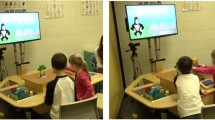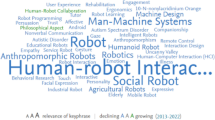Abstract
Socially assistive robots are a promising technology for supporting residential care facilities to provide stimulating recreational activities to residents in group settings. In order for caregivers to teach robots customized recreational activities for residents in their facilities, these robots need to be able to learn such activities from non-experts. In this work, we present a novel learning from demonstration system that allows socially assistive robots to learn customized group recreational activities from caregivers and facilitate these activities with users. We validate the usability and effectiveness of the proposed system by conducting a robot teaching study with caregivers and the Tangy robot at a local residential care facility. The caregivers found the learning system easy to use, experienced moderately low perceived workload, and were able to successfully teach Tangy the game of Bingo. Once Tangy learned the game, it autonomously facilitated Bingo games with elderly residents. The residents found the robot behaviors, personalized by the caregivers, both helpful and entertaining. Furthermore, they enjoyed playing Bingo with Tangy and would participate in future games.









Similar content being viewed by others

References
Thompson C et al (2017) The robot tangy facilitating trivia games: a teambased user-study with long-term care residents. In: IEEE international symposium on robotics and intelligent sensors, pp 173–178
Moyle W et al (2013) Exploring the effect of companion robots on emotional expression in older adults with dementia: a pilot randomized controlled trial. J Gerontol Nurs 39:46–53
Janke MC, Payne LL, Van Puymbroeck M (2008) The role of informal and formal leisure activities in the disablement process. Int J Aging Hum Dev 67:231–257
Fernández-Mayoralas G et al (2015) Active ageing and quality of life: factors associated with participation in leisure activities among institutionalized older adults, with and without dementia. Aging Mental Health 19:1031–1104
Kolanowski AM et al (2001) Capturing interests: therapeutic recreation activities for persons with dementia. Therap Recreat J 35:220–235
Chernova S, Thomaz AL (2014) Robot learning from human teachers. Synth Lect Artif Intell Mach Learn 8:1–121
Huang J, Lau T, Cakmak M (2016) Design and evaluation of a rapid programming system for service robots. In: ACM/IEEE international conference on human–robot interaction, pp 295–302
Niekum S et al (2015) Learning grounded finite-state representations from unstructured demonstrations. Int J Robot Res 34:131–157
Mohseni-Kabir A et al (2015) Interactive hierarchical task learning from a single demonstration. In: IEEE international conference on human–robot interaction, pp 205–212
Zhu Z, Hu H (2018) Robot learning from demonstration in robotic assembly: a survey. Robotics 7:1–25
Ryvicker M (2011) Staff-resident interaction in the nursing home: an ethnographic study of socio-economic disparities and community contexts. J Aging Stud 25:295–304
Louie W-YG, Nejat G (2016) A learning from demonstration system architecture for robots learning social group recreational activities. In: IEEE international conference on intelligent robots and systems, pp 808–814
Saunders J et al (2016) Teach me–show me?—End-user personalization of a smart home and companion robot. IEEE Trans Hum Mach Syst 46:27–40
Uyanik KF et al (2013) Learning social affordances and using them for planning. Proc Ann Meet Cognit Sci Soc 35:3604–3609
Louie WG et al (2014) A focus group study on the design considerations and impressions of a socially assistive robot for long-term care. In: IEEE international symposium on robot and human interactive communication, pp 237–242
Breiman L (2001) Random forests. Mach Learn 45:5–32
Fernández-Delgado M, Cernadas E, Barro S, Amorim D (2014) Do we need hundreds of classifiers to solve real world classification problems? J Mach Learn Res 15:3133–3181
Biau G, Scornet E (2016) A random forest guided tour. Test 25:197–227
Calinon S, Billard A (2007) Incremental learning of gestures by imitation in a humanoid robot. In: ACM/IEEE international conference on human–robot interaction, pp 255–262
Zhang T et al (2018) Robot imitation learning of social gestures with self-collision avoidance using a 3D sensor. Sensors 18:1–17
Kunstler R, Daly FS (2010) Therapeutic recreation leadership and programming. Human Kinetics Publishers, Champaign
Smith MC et al (1994) Age and skill differences in adaptive competence. Int J Aging Hum Dev 39:121–136
Sobel BP (2001) Bingo vs. physical intervention in stimulating short-term cognition in Alzheimer’s disease patients. Am J Alzheimers Dis Other Dement 16:115–120
Tak SH et al (2014) Activity engagement: perspectives from nursing home residents with Dementia. Educ Gerontol 41:182–192
Griol D, Callejas Z (2013) An architecture to develop multimodal educative applications with Chatbots. Int J Adv Rob Syst 10:1–15
Buchina N, Kamel S, Barakova E (2016) Design and evaluation of an end-user friendly tool for robot programming. In: IEEE international symposium on robot and human interactive communication, pp 185–191
Barakova EI, Gillesen JC, Huskens BE, Lourens T (2013) End-user programming architecture facilitates the uptake of robots in social therapies. Robot Auton Syst 61:704–713
Virzi RA (1992) Refining the test phase of usability evaluation: how many subjects is enough? Hum Factors 34:457–468
Turner CW, Lewis JR, Nielsen J (2006) Determining usability test sample size. Int Encycl Ergon Hum Fact 3:3084–3088
Hart G, Staveland LE (1988) Development of NASA-TLX (Task Load Index): results of empirical and theoretical research. Adv Psychol 52:139–183
Brooke J et al (1996) SUS—a quick and dirty usability scale. Usability Eval Ind 189:4–7
Kronander K, Billard A (2014) Learning compliant manipulation through kinesthetic and tactile human–robot interaction. IEEE Trans Haptics 7:367–380
Weiss A et al (2009) Teaching a humanoid: a user study on learning by demonstration with HOAP-3. In: IEEE international symposium on robot and human interactive communication, pp 147–152
Blume J et al (2013) Programming concept for an industrial HRI packaging cell. In: 2013 IEEE international symposium on robot and human interactive communication, pp 93–98
Butler JT, Agah A (2001) Psychological effects of behavior patterns of a mobile personal robot. Auton Robots 10:185–202
Forbes M et al (2014) Grounding antonym adjective pairs through interaction. In: ACM/IEEE international conference on human-robot interaction—workshop on humans and robots in asymmetric interactions, pp 1–4
Grier R (2015) How high is high? A meta-analysis of NASA-TLX global workload scores. In: Proceedings of the human factors and ergonomics society, pp 1727–1731
Bangor A et al (2009) Determining what individual SUS scores mean: adding an adjective rating scale. J Usability Stud 4:114–123
Bemelmans R, Gelderblom GJ, Jonker P, De Witte L (2012) Socially assistive robots in elderly care: a systematic review into effects and effectiveness. J Am Med Dir Assoc 13:114–120
Li J, Louie W-YG, Mohamed S, Despond F, Nejat G (2016) A user-study with Tangy the Bingo facilitating robot and long-term care residents. In: IEEE international symposium on robotics and intelligent sensors, pp 109–115
Acknowledgements
The authors would like to thank the staff and residents of our partner care facility for their support, assistance, and participation in these user studies. The authors also thank Sharaf Mohamed, Francis Despond, Christina Moro, and Tan Zhang for their assistance with the robot and teaching study.
Funding
This study was funded by the Natural Sciences and Engineering Council of Canada (NSERC), Dr. Robot Inc. and the Canada Research Chairs (CRC) program.
Author information
Authors and Affiliations
Corresponding author
Ethics declarations
Conflict of interest
The authors declare that they have no conflict of interest.
Informed Consent
Written consent was obtained from all participants prior to their participation.
Additional information
Publisher's Note
Springer Nature remains neutral with regard to jurisdictional claims in published maps and institutional affiliations.
Appendix
Appendix
1.1 Post-Interaction Questionnaire
1.1.1 Part A: Open-Ended Questions
-
1.
Did you find it easy to customize a new gesture for the robot?
-
2.
Would you prefer another method for teaching the robot a new gesture (e.g. keyboard and mouse, physically moving the robot’s arms)?
-
3.
Did you find it easy to customize new speech for an action?
-
4.
Would you prefer another method for inputting new speech (e.g. such as speaking into a microphone)?
-
5.
Was it useful to see what the robot saw in the Graphical User Interface?
-
6.
Was it useful to present information about the current activity that the robot is observing (e.g. if someone has requested for assistance, how a Bingo card has been marked by a player, the called out Bingo numbers).
-
7.
Was it useful to know what the robot has learned during the robot teaching session in the Graphical User Interface?
-
8.
Do you think you could develop new recreational activities for the robot to do with the residents using this system?
-
9.
Did you enjoy teaching the robot a new activity?
-
10.
Do you have any additional comments or suggestions?
1.1.2 Part B: NASA-TLX Task Load Index
Please place an “X” along each scale at the point that best indicates your experience during the robot teaching session, ranging from low to high for statements 1-5 and good to bad for statement 6.

-
1.
Mental Demand: How much mental and perceptual activity was required during the Bingo teaching task (e.g. moving arms, clicking the mouse, pressing buttons)? For example, was the Bingo teaching task easy or demanding, simple or complex, exacting or forgiving.
-
2.
Physical Demand: How much physical activity was required during the Bingo teaching task (e.g. pushing, pulling, turning, controlling, activating, etc.)? Was the Bingo teaching task easy or demanding, slow or brisk, slack or strenuous, restful or laborious?
-
3.
Temporal Demand: How much time pressure did you feel due to the rate or pace at which the Bingo teaching task occurred? Was the pace slow and leisurely or rapid and frantic?
-
4.
Effort: How hard mentally or physically did you have to work to teach the robot Bingo?
-
5.
Frustration: How discouraged, stressed, irritated, and annoyed versus gratified, relaxed, content, and complacent did you feel while teaching the robot.
-
6.
Performance: How successful do you think you were in accomplishing the goals of the Bingo teaching task? How satisfied were you with your performance in accomplishing these goals?
1.1.3 Part C: System Usability Scale
Please place an “X” to indicate your level of agreement to the following statements.

-
1.
I think that I would like to use the robot teaching system frequently to teach the robot to facilitate new leisure activities with residents.
-
2.
I found using the robot teaching system too complex.
-
3.
I thought the robot teaching system was easy to use.
-
4.
I think that I would need the support of a technical person who is always nearby to be able to use this robot teaching system.
-
5.
I found the various functions of the robot teaching system were well integrated.
-
6.
I thought there was too much inconsistency in the robot teaching system.
-
7.
I would imagine that most recreational activity program staff would very quickly learn to use the robot teaching system.
-
8.
I found the robot teaching system very cumbersome to use.
-
9.
I felt very confident using the robot teaching system.
-
10.
I needed to learn a lot of things before I could get going with the robot teaching system.
Rights and permissions
About this article
Cite this article
Louie, WY.G., Nejat, G. A Social Robot Learning to Facilitate an Assistive Group-Based Activity from Non-expert Caregivers. Int J of Soc Robotics 12, 1159–1176 (2020). https://doi.org/10.1007/s12369-020-00621-4
Accepted:
Published:
Issue Date:
DOI: https://doi.org/10.1007/s12369-020-00621-4



